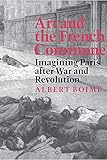Art and the French Commune : Imagining Paris after War and Revolution / Albert Boime.
Material type: TextSeries: Princeton Series in 19th Century Art, Culture, and Society ; 2Publisher: Princeton, NJ : Princeton University Press, [2022]Copyright date: ©1995Description: 1 online resource (256 p.) : 162 halftonesContent type:
TextSeries: Princeton Series in 19th Century Art, Culture, and Society ; 2Publisher: Princeton, NJ : Princeton University Press, [2022]Copyright date: ©1995Description: 1 online resource (256 p.) : 162 halftonesContent type: - 9780691239705
- ART / History / General
- Arc de Triomphe
- Arnold Hauser (art historian)
- Art Journal (College Art Association journal)
- Art critic
- Art world
- Au Bonheur des Dames
- Auguste Comte
- Battle of France
- Berthe Morisot
- Bonapartiste
- Boulevard des Capucines
- Bourgeoisie
- Camille Pissarro
- Charles Bonnet
- Charles Fourier
- Class analysis
- Claude Bernard
- Communards
- Comparative sociology
- Contemporary art
- Council of Paris
- Courbevoie
- Culture of France
- Edgar Degas
- Franco-Prussian War
- French Algeria
- French Army
- French Parliament
- French art
- French intervention in Mexico
- French people
- Gare Montparnasse (The Melancholy of Departure)
- Gazette des Beaux-Arts
- Georges Clemenceau
- Georges Seurat
- Gustave Caillebotte
- Gustave Courbet
- Gustave Le Bon
- Haussmann's renovation of Paris
- History painting
- House of Orléans
- Illustration
- Impressionism
- James Tissot
- Jardins
- Jean Grave
- Kunsthalle
- La Commune (Paris, 1871)
- La Revue Blanche
- Le Figaro
- Le Gaulois
- Le Monde
- Le Moniteur Universel
- Les Femmes
- Les Halles
- Les Temps modernes
- Literature
- Louis Althusser
- Louis Blanc
- Louis Philippe I
- Louise Michel
- Meyer Schapiro
- Modernism
- Modernity
- Molecule
- Nadar (photographer)
- Napoleon III
- Napoleon
- New France
- Observation
- Organic chemistry
- Paris Commune
- Paul Durand-Ruel
- Paul Gauguin
- Pierre Puvis de Chavannes
- Pierre-Auguste Renoir
- Pierre-Joseph Proudhon
- Pontoise
- Positivism
- Post-structuralism
- Prussia
- Radical History Review
- Radicalism (historical)
- Reform movement
- Revanchism
- Revue des deux Mondes
- Rue Saint-Denis (Paris)
- Rue de Rivoli
- Satire
- Siege of Paris (1870–71)
- Southern France
- T. J. Clark (art historian)
- The Civil War in France
- The Impressionists (BBC drama)
- The Realist
- Tuileries Palace
- Wood engraving
- Work of art
- École Normale Supérieure
- Édouard Manet
- 701/.03
- online - DeGruyter
| Item type | Current library | Call number | URL | Status | Notes | Barcode | |
|---|---|---|---|---|---|---|---|
 eBook
eBook
|
Biblioteca "Angelicum" Pont. Univ. S.Tommaso d'Aquino Nuvola online | online - DeGruyter (Browse shelf(Opens below)) | Online access | Not for loan (Accesso limitato) | Accesso per gli utenti autorizzati / Access for authorized users | (dgr)9780691239705 |
Browsing Biblioteca "Angelicum" Pont. Univ. S.Tommaso d'Aquino shelves, Shelving location: Nuvola online Close shelf browser (Hides shelf browser)
Frontmatter -- CONTENTS -- LIST OF ILLUSTRATIONS -- ACKNOWLEDGMENTS -- 1. INTRODUCTION -- 2. THE CRITICAL RECEPTION -- 3. THE DISLOCATING IMPACT OF THE COMMUNE ON THE IMPRESSIONISTS -- 4. THE IMPRESSIONIST AGENDA -- 5. MAPPING THE TERRAIN -- EPILOGUE: GEORGES SEURAT'S Un Dimanche a la Grande Jatte AND POST-COMMUNE UTOPIANISM -- APPENDIX: ON OLIN LEVI WARNER'S DRAFT OF A SPEECH IN DEFENSE OF THE FRENCH COMMUNE -- NOTES -- INDEX
restricted access online access with authorization star
http://purl.org/coar/access_right/c_16ec
In this bold exploration of the political forces that shaped Impressionism, Albert Boime proposes that at the heart of the modern is a "guilty secret"--the need of the dominant, mainly bourgeois, classes in Paris to expunge from historical memory the haunting nightmare of the Commune and its socialist ideology. The Commune of 1871 emerged after the Prussian war when the Paris militia chased the central government to Versailles, enabling the working class and its allies to seize control of the capital. Eventually violence engulfed the city as traditional liberals and moderates joined forces with reactionaries to restore Paris to "order"--the bourgeois order. Here Boime examines the rise of Impressionism in relation to the efforts of the reinstated conservative government to "rebuild" Paris, to return it to its Haussmannian appearance and erase all reminders of socialist threat. Boime contends that an organized Impressionist movement owed its initiating impulse to its complicity with the state's program. The exuberant street scenes, spaces of leisure and entertainment, sunlit parks and gardens, the entire concourse of movement as filtered through an atmosphere of scintillating light and color all constitute an effort to reclaim Paris visually and symbolically for the bourgeoisie. Amply documented, richly illustrated, and compellingly argued, Boime's thesis serves as a challenge to all cultural historians interested in the rise of modernism.
Mode of access: Internet via World Wide Web.
In English.
Description based on online resource; title from PDF title page (publisher's Web site, viewed 29. Jun 2022)









